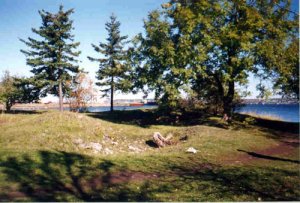The Mathews Family
1785-1800
David Mathews was a United Empire Loyalist who came to Cape Breton in 1785. He was married to Sarah Seymour and they had at least four children, two sons and two daughters. He was granted a large tract of land on the western side of Sydney Harbour and is said to have named the area Point Amelia after one of his daughters. Today, Point Amelia is located at the northeastern tip of the present-day Petersfield Provincial Park.

Point Amelia today
As a former mayor of New York, Mathews had lost a considerable amount of property in the American Revolution and wished to repair his fortunes in Sydney. While little is known about the Mathews estate, one can surmise that it was one of the more lavish and prestigious properties of colonial Cape Breton.
Mathews quickly became involved in the political life of the newly formed colony of Cape Breton by becoming a member of the Executive Council and Attorney-General. He was a member of a faction of the Executive Council led by Abraham Cuyler, a former mayor of Albany, New York. This faction was often involved in political power struggles within the colony and opposed decisions made by Lieutenant-Governor Joseph Frederick Wallet DesBarres. Provisions had been made for the Cape Breton colony to organize its own house of assembly but this assembly was not convened because the British government believed that the colony needed to have a larger population to warrant such an assembly. Therefore, all decisions were to be made by the Executive Council, but because of the dispute between the two factions, effective government was impossible. Mathews helped to oust Governor DesBarres in 1786. He then became a friend of the next lieutenant governor, William Macarmick. He fell out of favour with Macarmick in 1794 and then Macarmick left the colony in 1795. As senior councillor, Mathews held the position of Colonial Administrator from 1795-1798. He used this office to appoint family and friends to positions of power and to remove his enemies from council. The next lieutenant-governor, Major-General James Ogilvie replaced Mathews as administrator. Ogilvie stayed in Cape Breton for one year only and the next administrator, General John Murray arrived in 1799. Mathews and Murray clashed over several issues and Murray relieved Mathews of his position of Attorney-General in January 1800. Mathews died in July 1800 at Point Amelia.
In addition to his contributions within the political life of the Cape Breton colony, Mathews left clues to what life was like in the eighteenth century. Archaeologists have been able to research the remains of his estate in Amelia Point, while botanists have found interesting examples of plants at Amelia Point. According to Mary Williams' report on the flora of Petersfield, there are two main areas to consider when looking at the plants of the David Mathews' estate and surrounding area. They are: 1) Amelia Point, itself, and 2) the early settlers' garden.
At Amelia Point, hops and spearmint were found near the foundation of a building. These plants date back to the Mathews occupation. Hops was used in bread and beer making while spearmint was used as a medicinal and for flavouring. Self-heal or heal-all, as its name suggests, was used to heal wounds and was found near the hops and spearmint. A Rambler Rose was also found near one of the foundations. There are also several tree species found at Amelia Point such as Quaking Aspen, European Ash and Balsam Poplar. The Balsam Poplar's existence at Amelia Point is significant for two reasons. A sticky, aromatic substance is found in the balsam poplar's buds and was used to treat respiratory ailments. The tree's soft wood was easily carved into cooking implements, crates and baskets. Other tree species found at Amelia Point include the English Hawthorn and Cockspur Thorn. Since they are non-native to the area, questions exist regarding these trees' placement here.
An early settlers' garden can be found near the Amelia Point site. There is a wide array of plants located in this section with varying age ranges. This area is a good example of the mixture of plants found in the park and the difficulty of dating them. For example, a hedgerow composed of three species of hawthorn, two species of lilac, several species of fruit tree, chokecherry and barberry exists here. The barberry is most likely the oldest of all the hedgerow's plants. The entire hedgerow would have been used to keep animals fenced. Some of the other plants located in the area of the early settlers' garden include: daphne, woodbine honeysuckle, false spirea, hops, goutweed, bittersweet nightshade, columbine, toadflax, queen of the meadow, wych elm and Camperdown elm. However, two of these plants were brought to this location after the David Mathews period. The goutweed was most likely placed there by the McLennans and the Camperdown elm may have been placed by either the Crawleys or the McLennans. This particular type of elm was established in the Halifax Public Gardens in 1899.


